Ultimate Guide to B2B Lead Nurturing
Master the art of turning prospects into loyal clients with actionable strategies and expert insights.
— Propoze
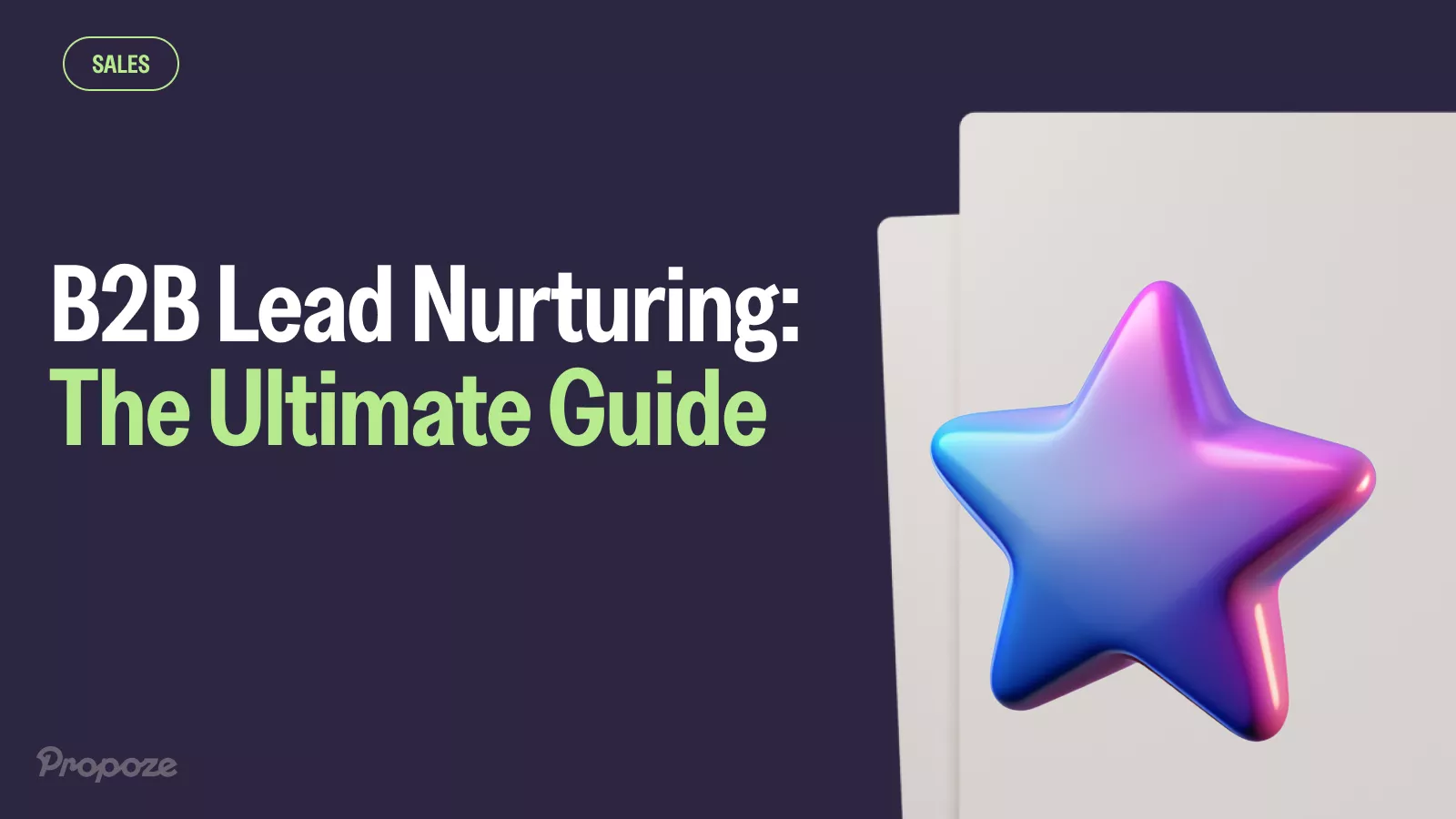
Lead nurturing is the heart of building lasting relationships and converting curious prospects into loyal clients.
Think of it as a series of well-timed conversations where you’re not just selling but helping solve real challenges, gaining trust along the way. Whether through a friendly check-in email, sharing helpful resources, or guiding leads step-by-step —a great lead nurturing process connects you with the right people at the right time.
Let’s dive in and explore how you can make lead nurturing a key part of your sales strategy!
What is lead nurturing in B2B?
Lead nurturing is the art of turning initial curiosity into trust, and, eventually, a partnership. Instead of simply generating new leads, nurturing means guiding those you’ve already connected with by offering helpful insights, personalized resources, and staying top-of-mind.
For example, imagine a prospective client downloads your guide on “2024 Marketing Trends.”
They’re curious, but not yet committed. Rather than diving into a hard sell, nurturing would mean following up with tailored emails — maybe a case study on how you’ve tackled similar challenges or an invite to a relevant webinar.
This way, you’re not just another brand in the ocean. You’re their go-to resource, building credibility until they’re ready to take the next step.
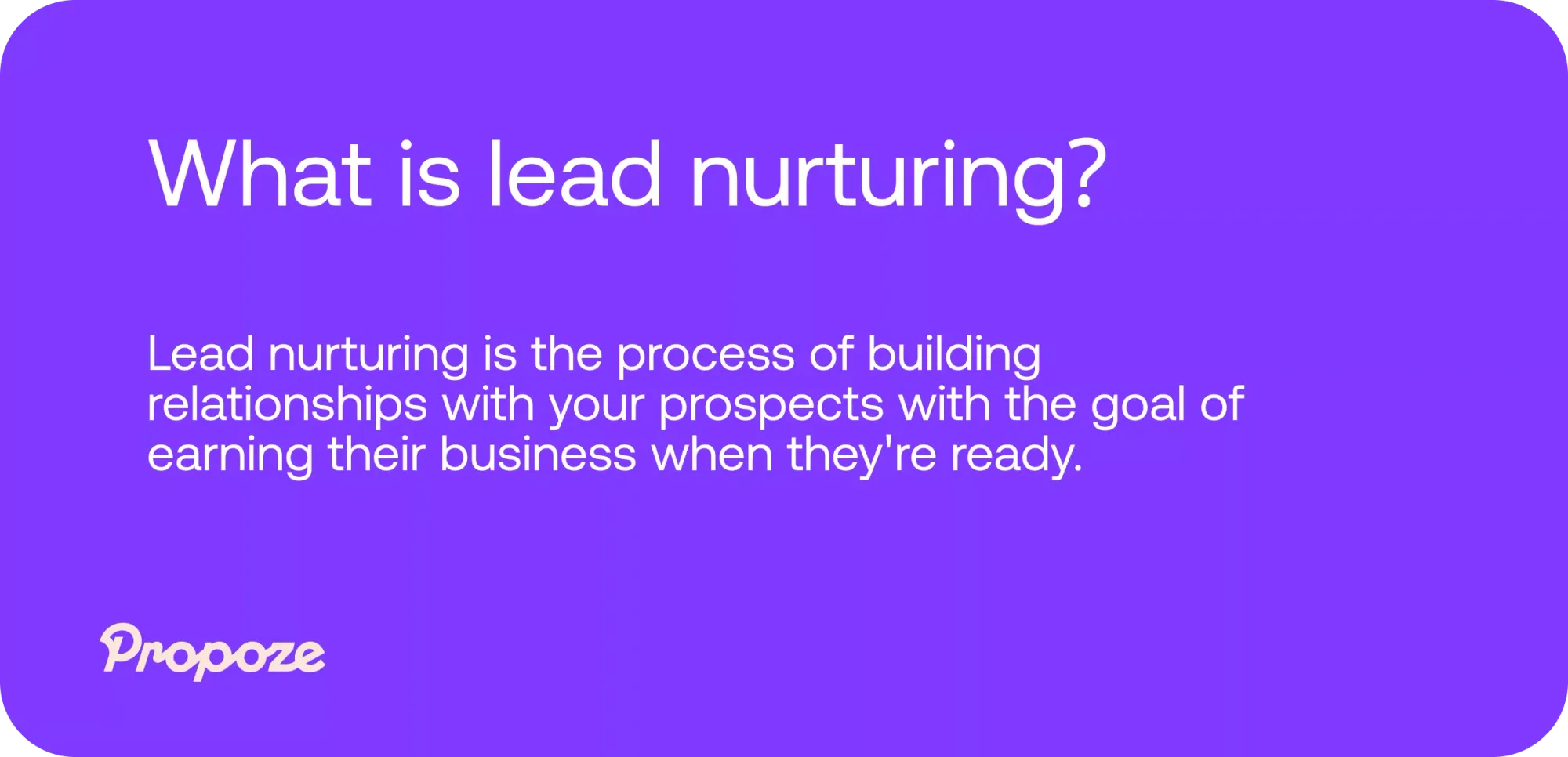
Why does lead nurturing matter in B2B?
Lead nurturing in B2B is a strategic process that turns initial interest into trust and commitment. Imagine it as a series of meaningful interactions, each step aligning prospects closer to your solution.
Here’s why it matters:
- Quality over quantity: Nurturing lets you qualify leads, filtering for those truly interested. This means higher-quality conversations with prospects more likely to convert.
- Shortened sales cycle: By engaging leads over time with relevant content, you’re guiding them down the path to purchase at a natural pace. By the time they’re ready to talk numbers, they’re already informed and excited.
- Building loyalty and trust: Regular, helpful contact builds a relationship. When prospects feel like they know and trust you, they’re far more likely to choose your solution.
Consider an example: a lead downloads your case study.
Rather than leaving it at that, you follow up with content that deepens their interest — a webinar invite, perhaps, or an email highlighting how your solution tackles industry-specific challenges. Each touchpoint adds value, turning cold leads into warm ones.
And your nurtured leads aren’t just one-time buyers. When they feel a genuine connection and see how much you’ve invested in their success, they’re more likely to become repeat clients and even advocates.
4 key elements of a lead nurturing strategy
Creating a lead nurturing strategy is akin to crafting a perfect blend of timing, personalization, and tech-savvy follow-ups. Here’s a quick look at the core elements:
- Segmentation: Not all leads are alike. Grouping them based on factors like industry, interest level, or behavior lets you tailor messages that resonate.
- Personalized content: Leads appreciate a personal touch. Creating content that speaks to their unique needs and challenges builds trust and relevance.
- Timely follow-ups: A well-timed message is everything. Regular, strategic touchpoints keep your brand top-of-mind without overwhelming.
- Automation: Streamline the process with tools that deliver the right content to the right people at the right time, ensuring consistency while saving time.
Each element strengthens the others, making your lead nurturing process cohesive and effective.
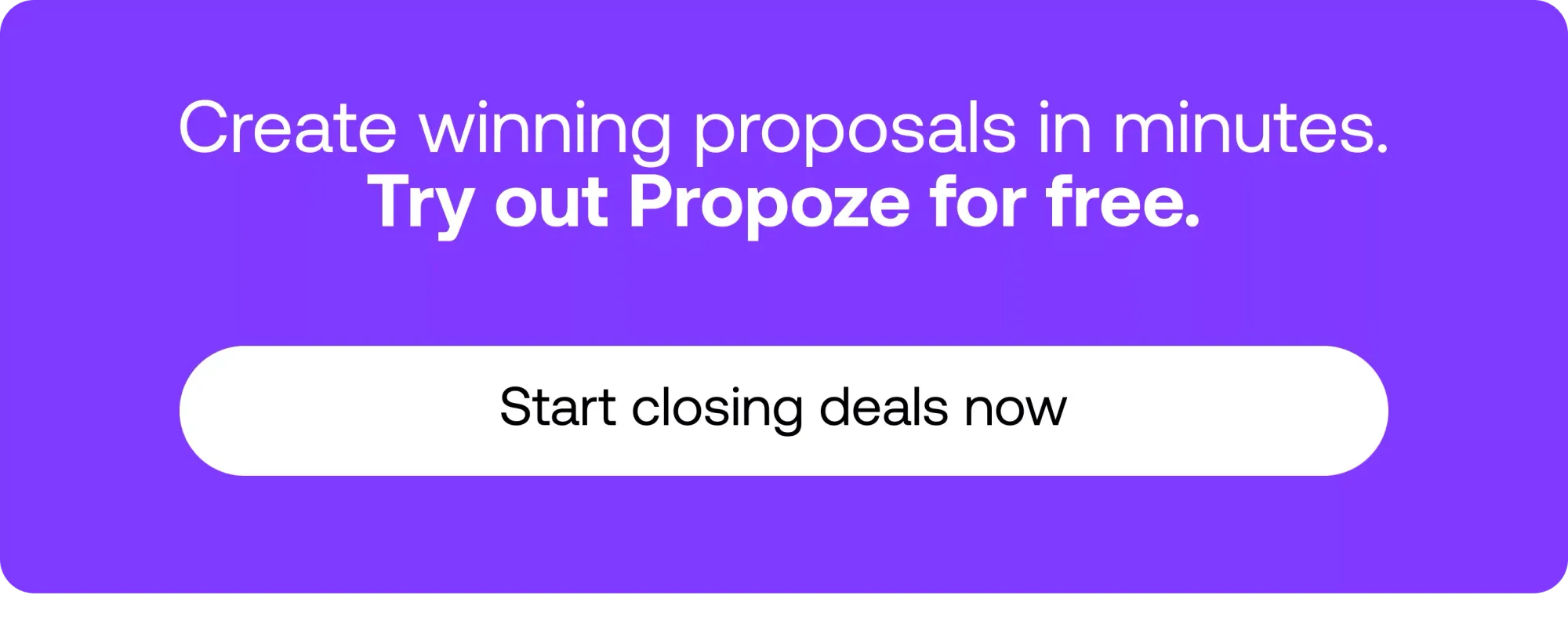
Element 1: Segmentation for targeted nurturing
Segmentation is the practice of dividing leads into specific groups based on characteristics like behavior, interests, or demographics.
Why does this matter?
With segmentation, you’re able to speak directly to each group’s needs, making your lead nurturing strategy more impactful. Instead of a one-size-fits-all approach, segmentation lets you deliver messages that resonate, improving engagement, open rates, and conversions.
There are 3 types of segmentation:
- Behavior-based: Segment by interactions — like those who’ve visited your pricing page or signed up for a webinar.
- Interest-based: Group leads based on specific interests they’ve shown, such as a particular product or feature.
- Demographics: Categorize by industry, job role, or company size, tailoring content that matches their unique priorities.
Here’s an example.
Imagine a lead who frequently downloads whitepapers about data security. With segmentation, you can follow up with a case study showcasing your security features, highlighting exactly what they care about.
Another lead might be browsing your pricing page repeatedly. For them, sending a personalized discount or product comparison could be the perfect next step.
Using targeted messages through segmentation boosts open and click-through rates by aligning content with real interests and needs. For instance, segmented campaigns see a 14.3% higher open rate and a 101% increase in clicks, simply because they feel more relevant to each lead.
So start small. Create a few groups based on available data, like engagement or demographics. As you collect more data, refine and add more granular segments for better precision.
To make all this easier, automation tools make segmentation scalable by helping you manage multiple groups at once. And here's a list of the best ones to make your life easier.
With automation, each segment can receive the right message at the right time — allowing you to maintain a personalized approach, even as you grow.
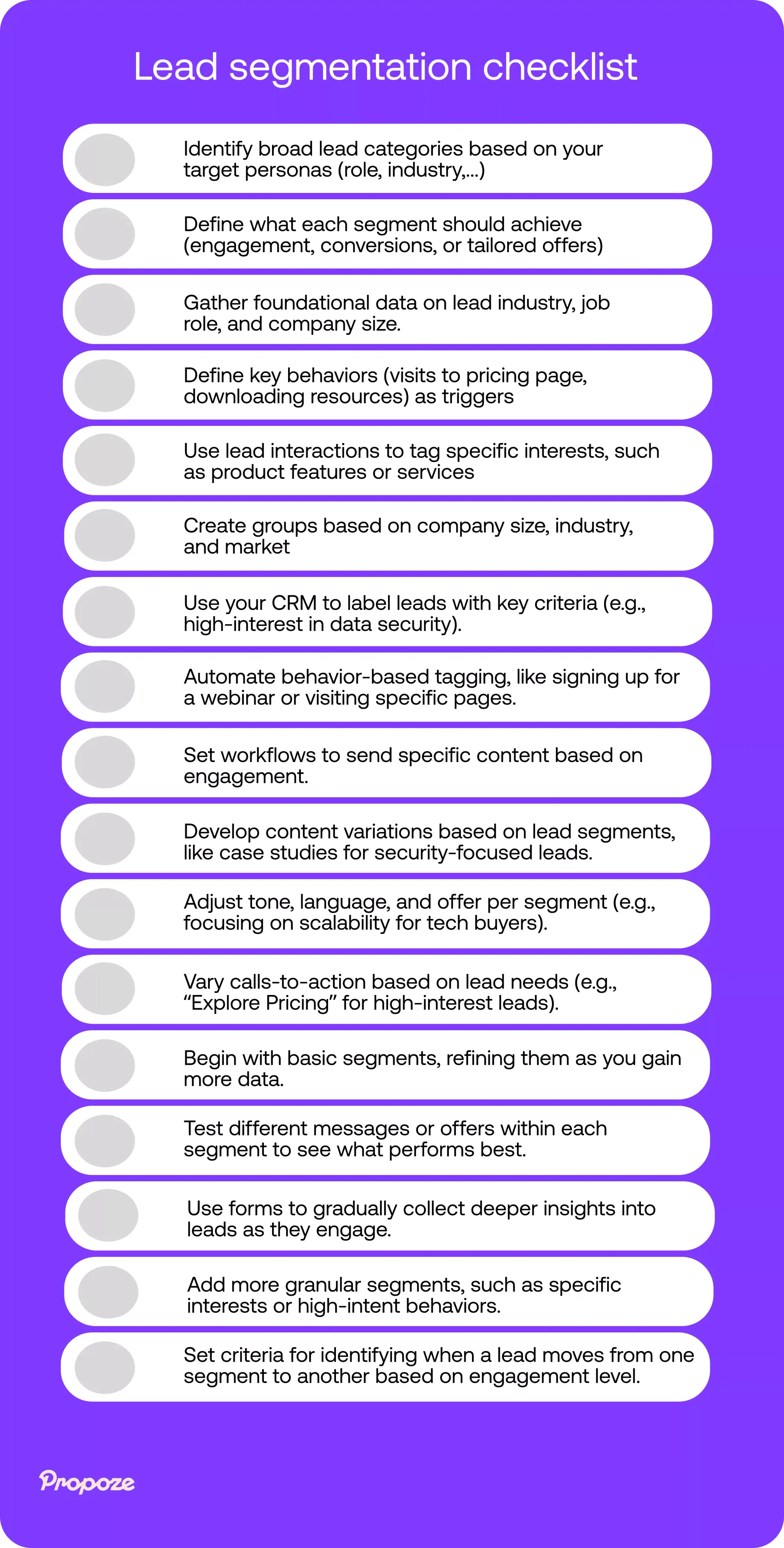
Element 2: Crafting personalized content
Personalized content is all about showing genuine insight into their needs and tailoring your message to make them feel understood.
In lead nurturing, personalization becomes a powerful tool, transforming standard emails into messages that resonate deeply and build trust.
Studies show that personalized emails can deliver a 29% higher unique open rate and 41% higher click-through rate than non-personalized counterparts — proving that tailored messaging captures attention and drives action.
Here are a few examples of personalization types.
- Behavior-based examples: Personalize based on user actions. For instance, if a lead regularly visits your blog to read content about cost-saving strategies, follow up with a downloadable guide on budgeting tips. Leads who have attended a recent webinar might appreciate a recap email that offers a deeper dive into the session topic or links to additional resources.
- Pain point-focused: When you know a specific challenge a lead is facing, such as concerns about ROI, deliver content that speaks directly to that issue. A case study that demonstrates how similar businesses achieved measurable savings through your solution can highlight the value you bring to the table.
For leads who show repeated interest in pricing pages, a targeted email offering a product demo or personalized cost breakdown can show you’re attentive to their journey. Research indicates that such specific targeting can lift conversion rates by up to 20%, as it addresses the precise interests of the lead.
According to Campaign Monitor, personalized emails see a 26% increase in open rates and a 760% increase in revenue from segmented campaigns.
Here are some tips on how to start:
- Start simple: Begin with broad segments, such as industry or engagement level, and gradually refine these segments as you gain more insights.
- Use templates: Create a set of core email templates that you can adjust based on each segment’s unique traits.
- Refine with data: Regularly analyze engagement data to understand what resonates best with each segment, and continue to adjust your messaging to stay relevant.
Personalized content turns lead nurturing into a valuable experience for the prospect, making every interaction feel purposeful and well-considered. This approach helps foster a meaningful connection and keeps your brand top-of-mind, moving leads closer to conversion.
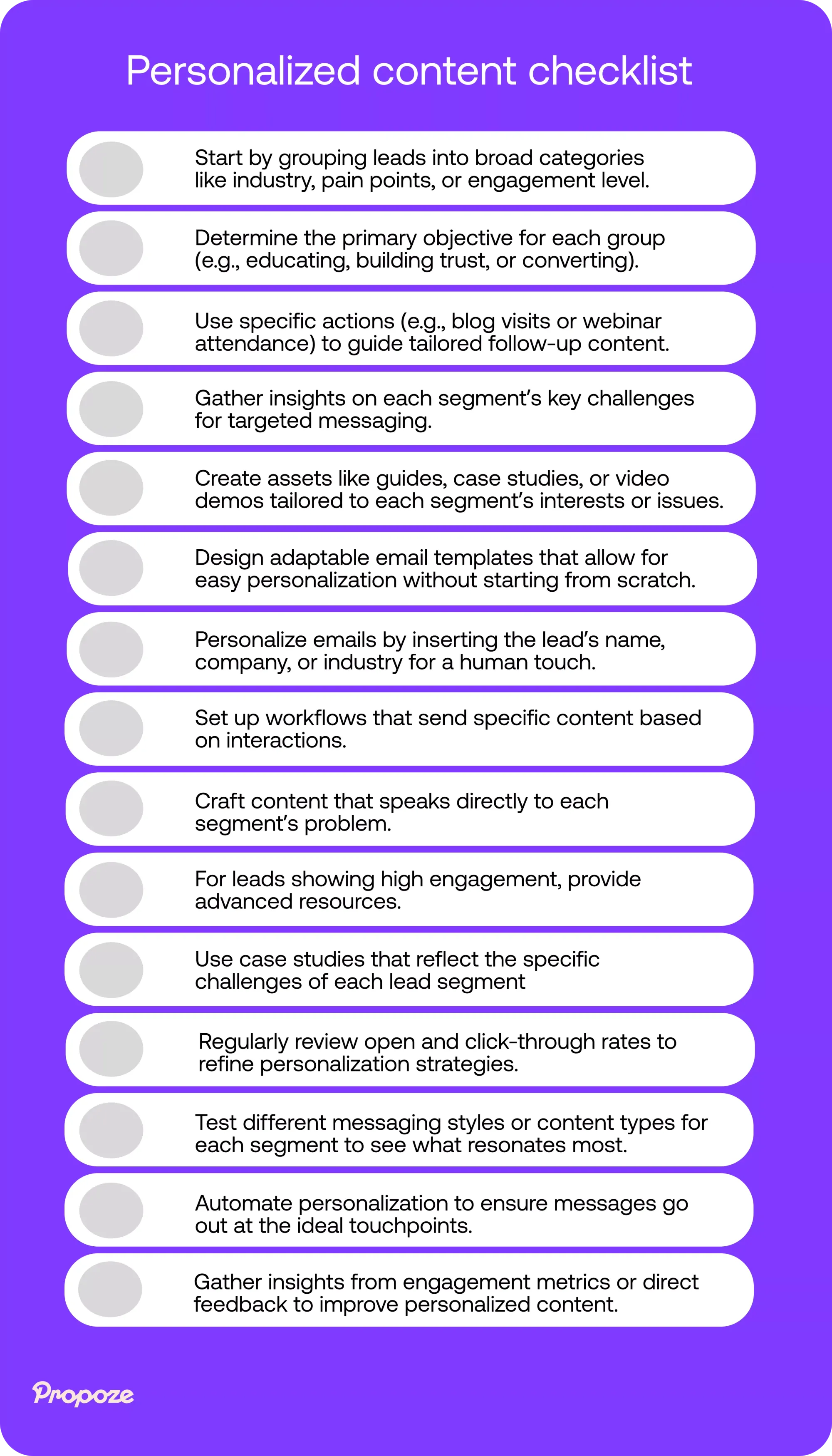
Element 3: Automation in lead nurturing
Let’s face it: nurturing leads without automation is like trying to juggle with one hand tied behind your back.
Automation steps in to handle the repetitive stuff so you can focus on building relationships. It’s a tool that sends the right messages at the right times, helps you keep tabs on engagement, and makes sure no lead ever falls through the cracks.
First, you’ll need to know what are the types of automation in lead nurturing:
- Email automation: Ever get a perfectly timed email that feels like it read your mind? That’s the power of email automation. With automation, you can set up welcome sequences for new leads, follow-ups, or even gentle nudges for those lingering on your pricing page. This ensures your leads are always getting relevant information at each stage of their journey—without you having to hit “send” manually.
- Triggered responses: Think of triggers as your digital butler, responding to each lead’s actions. Let’s say a lead downloads your eBook; automation can instantly send a “Thanks, here’s a bonus guide!” email. If they register for a webinar, automation ensures they get reminder emails. It’s like having a personalized touchpoint for each engagement, except you’re not glued to your desk!
- Engagement tracking: Automation tools can track who’s opening your emails, clicking on links, and spending time on your site. This lets you know who’s actually interested versus who’s just window shopping. With these insights, you can follow up with high-interest leads while keeping lower-priority ones warm.
Now, let’s take a look at some real-life use cases.
Picture this: A new lead signs up for your SaaS free trial. Automation sends a sequence introducing them to your product’s key features, showing them how to make the most of the trial. Before you know it, they’re hooked, and all you did was set it up once.
Here’s another example for agencies.
A lead downloads a content marketing guide from your agency website. Automation then sends follow-up content tailored to that interest, like blog posts on advanced content strategies or case studies on campaign results. This keeps your brand top of mind with zero extra effort.
Automating your lead nurturing offers a triple win — time saved, consistency guaranteed, and lead engagement boosted.
With automation, you never accidentally ghost a lead or miss a follow-up. Your leads receive steady, valuable communication, and when they’re ready to convert, you’re already top of mind.
Some automation tools that make nurturing a breeze:
- HubSpot: Great for creating workflows and tracking engagement with features like advanced lead scoring and robust CRM integrations, HubSpot makes it easy to personalize interactions based on each lead’s journey stage.
- Zapier: Known for its versatile integrations, Zapier allows you to connect different apps, creating automated workflows across platforms. For example, you can set triggers to automatically move new leads from web forms into your CRM or send personalized follow-up emails without manual input.
- Make.com: With its visual workflow builder, Make.com offers a user-friendly way to design custom automations. You can map out intricate lead-nurturing flows that pull data from multiple sources, enabling you to scale personalization while keeping things organized.
Each of these tools brings unique advantages for B2B lead nurturing, from enhanced tracking to multi-platform automation.
But even if you had the tools and you’re ready to start, what should you do first?
Start with the basics. Begin with an introductory email series or a simple lead qualification workflow. As you see what resonates, expand your automation.
Keep an eye on performance metrics and tweak as you go. Just because it’s automated doesn’t mean it should be static.
Finally, ensure that each workflow has a purpose that directly impacts your goals. Automation should make your lead nurturing seamless, but it should also support your larger sales objectives.
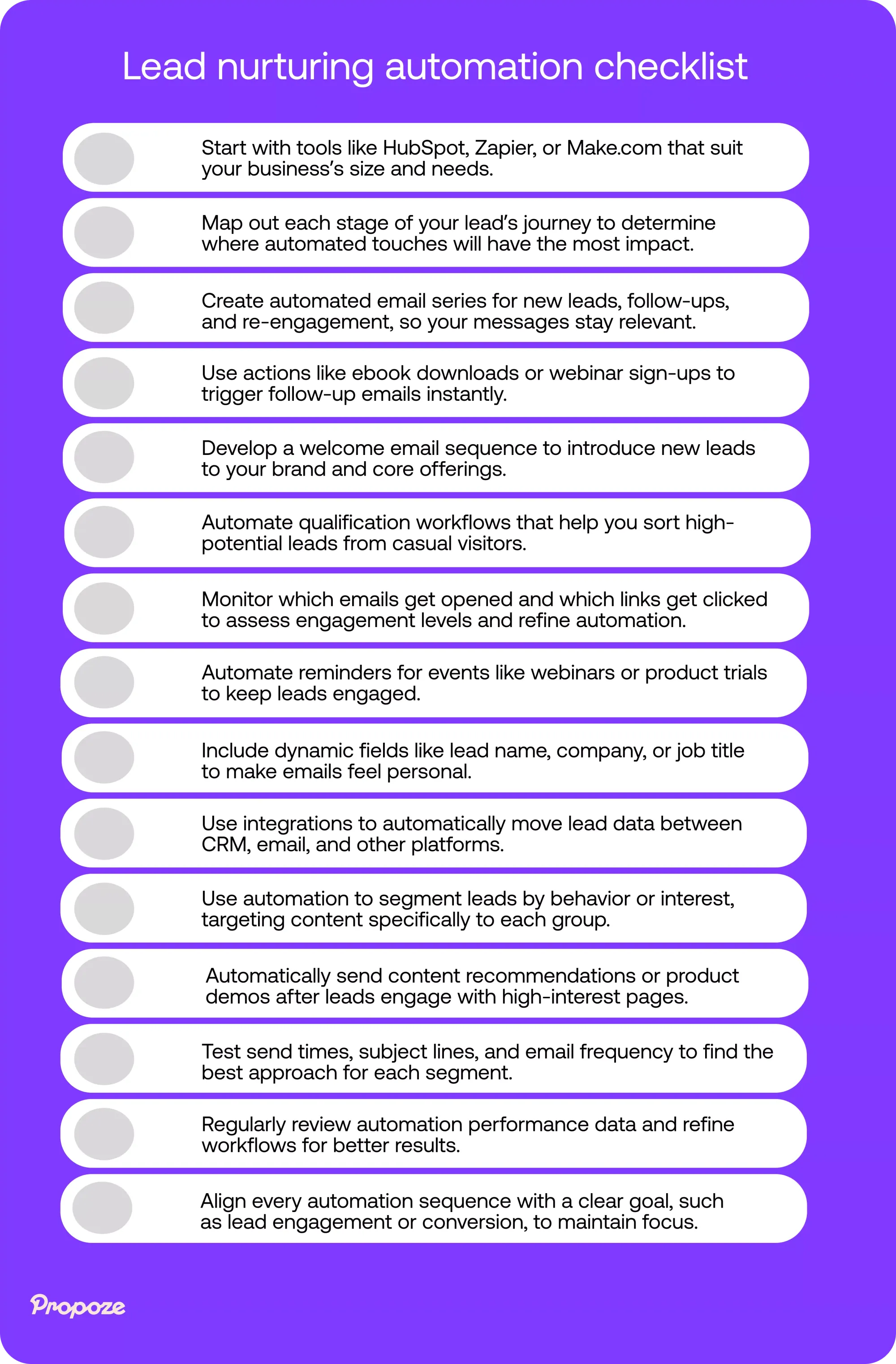
Element 4: Timely follow-ups
Let’s talk follow-ups. A well-timed follow-up can be the difference between staying relevant and getting lost in the inbox clutter.
Done right, timely touchpoints make your brand memorable without overwhelming your leads.
Here’s how to nail the timing and keep your leads warm.
First, you’ll have to set the right cadence. Finding the right cadence — how often to follow up — depends on the type of lead and their engagement level:
- High-interest leads: For leads who frequently visit key pages or attend webinars, follow up within 24-48 hours with a message that builds on their interest. For example, send a thank-you email after a webinar with a bonus resource or offer.
- Moderately interested leads: Leads that engage sporadically benefit from a “check-in” every 1-2 weeks to keep the momentum going without overwhelming them.
- Low-interest or cold leads: Touch base once a month to stay on their radar, sharing value-driven content that might pique their interest again.
For example, if a lead downloads an eBook, follow up with a related blog post or a quick message like, “Glad you found our eBook helpful! Here’s another resource you might enjoy.”
Or, if you’re running a webinar, send a thank-you email within 24 hours after the webinar is finished, along with a special offer or a helpful summary.
And especially if you’re dealing with cart/form abandonment. Timing is key for these leads — try a follow-up within a few hours, reminding them of the value they showed interest in.
Automation tools like Apollo or HubSpot help keep these follow-ups timely without requiring manual scheduling.
However, personalizing these follow-ups makes a big difference. Using the lead’s name, referring to a specific interaction, or mentioning details about their business can turn an automated email into a meaningful connection.
You’ll need to monitor engagement with your follow-ups to refine timing. If emails sent within 24 hours get higher responses than weekly check-ins, adjust your cadence to focus on more immediate follow-ups.
As always, this isn’t a “copy and paste” solution. You’ll have to experiment with timing, track open and response rates, and segment for precision.
Timing isn’t just a detail — it’s the strategy. With a well-timed follow-up, you keep your brand front-and-center, building connections that ultimately lead to conversions.

5 common lead nurturing campaigns (+ examples)
Each lead nurturing campaign plays a unique role in guiding prospects from that first connection to a lasting relationship.
Here’s a quick look at the core campaigns.
- Welcome campaigns: The warm intro that sets the tone, welcoming leads and setting clear expectations.
- Educational nurturing: Content that builds trust and showcases your expertise by addressing your leads’ pain points and needs.
- Re-engagement campaigns: Perfect for re-igniting interest with leads who have gone quiet, reminding them of your value.
- Product launch campaigns: Creating buzz around new offerings, these campaigns generate excitement and showcase fresh solutions.
- Upsell and cross-sell nurturing: Helping current customers see added value by introducing complementary products or services.
1) Welcome campaigns
Welcome campaigns are the B2B equivalent of rolling out the red carpet for your leads. This is your shot at setting the tone, showing them what you’re all about, and making sure they know they’re in the right place.
Now, how to make that first impression memorable?
First, you’ll have to start with the right hello.
Skip the generic “Welcome to our newsletter” vibe.
Make your opehichning message feel like a real introduction — let your brand’s voice shine through. Are you friendly, quirky, or professional? Give leads a peek at your brand personality so they feel like they’re getting to know the real you.
Next, try to set expectations and build curiosity.
People appreciate knowing what to expect, so give them the rundown. Share what kind of content you’ll send (like tips, insights, or industry updates) and how often.
Adding a hint of mystery — like “We’ve got some exclusive resources coming your way” — can build a sense of curiosity and excitement.
Also, you’ll need to guide them to the good stuff.
New leads can easily get lost, so help them explore by highlighting a few key resources. Link to your top blog post, a must-read case study, or a quick demo.
Think of it as giving them a map to navigate your brand and find value right away.
And don’t overwhelm them with too much info in one go. Wrap up with a single, friendly call-to-action that invites them to dive a little deeper — “Ready to explore more? Check out our blog,” or “Take a look at our latest success stories.”
With a welcome campaign that covers these bases, you’re setting the stage for a relationship built on trust and real value. Get the tone right here, and you’ll see leads stick around, ready for the next step.
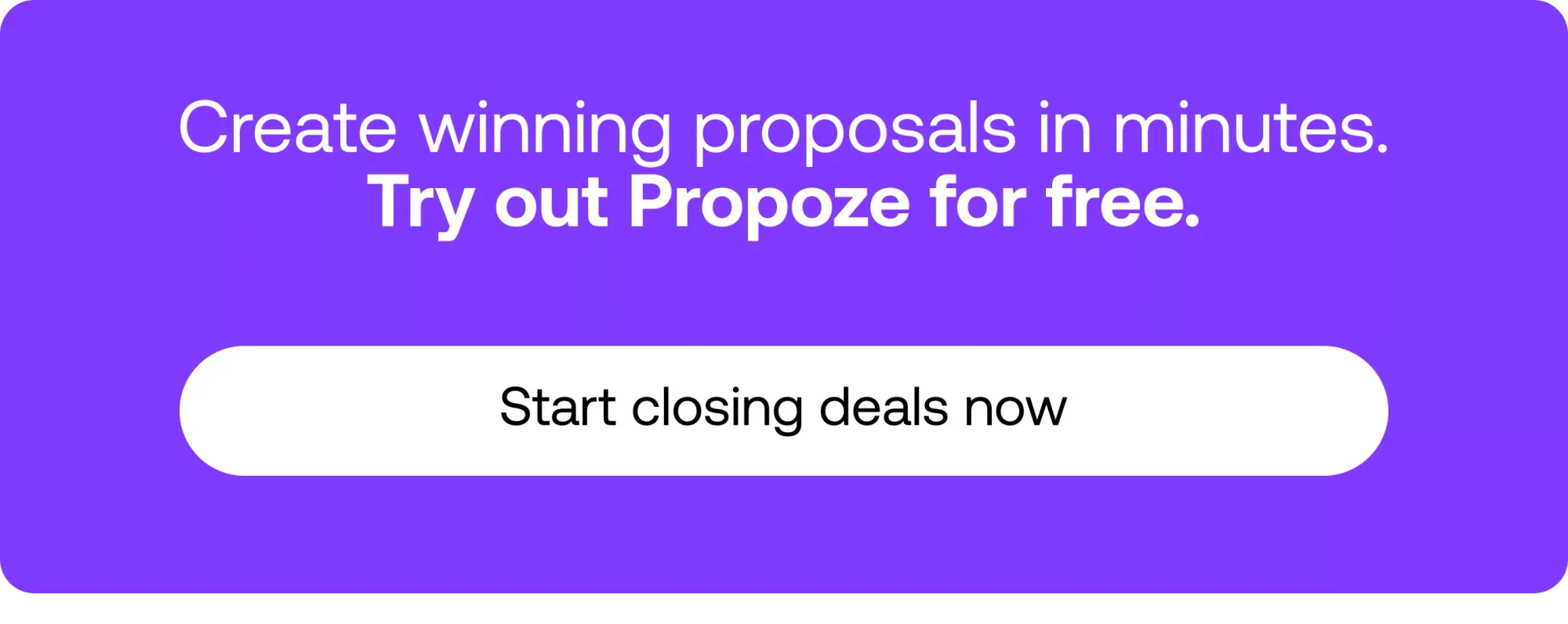
2) Educational nurturing
Educational nurturing is about showing up with the right knowledge, right when your lead needs it. Think of it as a way to build trust and add value without asking for anything in return — like the brand equivalent of giving good advice over coffee.
Just imagine if every email, whitepaper, or guide felt like that satisfying “Aha!” moment — yeah, that’s the goal here.
So, what kind of content works best for educational nurturing?
- Case studies: Stories of real-life success make complex solutions relatable. If you have a case study that showcases a client in their industry who benefited from your product, this is the perfect stage to share it.
- Whitepapers and guides: Go deep into relevant topics, showing you understand the industry inside out. An example? A guide on “Top Compliance Challenges in (Industry)” positions you as someone who gets it.
- Webinars and short videos: Give leads a way to consume insights on the go. A quick webinar on “Top 5 Lead Gen Tips for B2B” can showcase your thought leadership without being pushy.
- How-to articles: Leads love actionable advice. Think guides on topics like “5 Steps to Increase Team Efficiency” that offer quick, practical solutions.
Now, personalization is where the magic happens. A lead in healthcare might appreciate insights on regulatory compliance, while someone in tech might be more interested in data security.
Segment your audience so they’re getting content that actually speaks to their unique challenges.
This isn’t about one-size-fits-all; it’s about delivering tailored value.
Once you’ve set up your educational nurturing campaign, you’ll have to keep an eye out for results.
Track open rates, click-throughs, and how long they’re engaging with the content.
Are they downloading resources? Signing up for webinars? These engagement metrics give you valuable insights into what’s working and who’s ready for the next step.
Educational nurturing done right builds trust and positions you as a go-to resource. You’re helping leads see you as an expert, so when the time’s right, they’ll come to you — no hard sell needed.
3) Re-engagement campaigns
Re-engagement campaigns are like a friendly tap on the shoulder for leads who’ve gone a little chilly. They’re a way to remind them, “Hey, remember us? We’re still here and have some cool new stuff to share!”
If done right, re-engagement campaigns can turn a silent prospect into an eager one. Here’s how to master the art of re-engaging those cold leads.
First, think about approaching with a fresh offer or update.
Sometimes, leads fall off simply because the timing wasn’t right or because they didn’t see enough value at the time. Now that you’ve improved your offering, why not let them know?
Try hitting them with a fresh discount, an added feature, or even a limited-time offer.
Make it clear that this isn’t just another sales email — it’s something that could really help with their current challenges.
The content you share with them must be impossible to ignore.
- Case studies and success stories: Share how you’ve helped similar clients achieve their goals.
- Guides and whitepapers: Fresh insights or a “how-to” guide can demonstrate the impact of your product.
Also, if you have a new product update, that’s a perfect excuse to reconnect!
If you’ve rolled out features they once mentioned wanting, or added new integrations that would be valuable for their industry, send them a quick update.
Try a subject line like, “New Features You’ve Been Waiting For” or “Exciting Updates in [Product Name].” A quick teaser email about these changes is often just enough to pique their interest.
Another thing that really matters here is — timing.
Reach out periodically without flooding their inbox. Think quarterly updates or event-based timing, like when you have a product launch, industry insight, or something that directly connects to their interests.
A steady, respectful cadence keeps you top-of-mind without feeling spammy.
With these strategies, re-engagement campaigns become a way to warm up the connection and invite leads back into the conversation.

4) Product launch campaigns
Picture this: you’ve got a shiny new product or an exciting feature update that’s about to drop, and you want to make sure your leads don’t just see it — they feel the excitement!
Product launch campaigns are like a mini event that tells your audience, “Hey, something big is here, and it’s exactly what you’ve been waiting for.”
Think of this as the "coming soon" phase that gets people curious. Drop hints, share a countdown, or send a sneak peek that gives just enough info to get them hooked.
One thing you need to do here is — connect the launch to a real problem your leads face.
Leads need to see how this launch solves a pain point, not just adds another tool to their stack. Spell out how this update directly addresses a challenge — like helping them save time, boost efficiency, or reduce costs.
For example, if you’re launching a time-tracking feature, highlight, “Now there’s no need to juggle multiple tools to stay on track. [New feature] has it all in one place!”
Keep in mind, everyone loves to feel like an insider.
Offering early access to a select few, or sending VIP invites to your most engaged leads, can create a sense of exclusivity.
Personalized demo invites with a message like, “Be one of the first to experience (new feature) in action!” make them feel like they’re getting special treatment.
And a live event adds even more excitement and lets your leads see the product in action. You could:
- Demo the new product
- Do a Q&A sessions
- Invite early testers to share their results
But you shouldn’t let the excitement drop right after. After launch day, follow up with content that dives deeper into the product benefits. Case studies, user stories, or a quick recap for those who missed the event can keep momentum going.
Also, try a “What You Missed” email for leads who didn’t open the initial messages or attend the launch event.
Launching a product means you'll want to be reconnecting with your leads, sparking curiosity, and helping them see how the update will make their work lives easier. Make it memorable, keep them engaged, and watch your product become the go-to solution they didn’t even know they needed.
5) Upsell and cross-sell nurturing
Alright, so you’ve got your clients onboard, and they’re loving what you’ve done for them so far.
But instead of just waiting for the next project, upsell and cross-sell nurturing gives you a natural way to build on that relationship by offering more solutions that truly meet their evolving needs.
It’s not about pushing products — it’s about being that go-to partner that’s ready with just the right solution at the right time.
First things first, listen to what your clients are saying (or not saying) in your check-ins or catch-ups.
Are they hinting at challenges that your current package doesn’t fully cover? Maybe they’re growing, and you have an add-on that scales with them.
Look for signs like increased usage or recurring mentions of new goals. If they’re maxing out their current plan, it could be the perfect moment to suggest an upgrade that helps them keep up with demand.
Key steps in building a B2B lead nurturing workflow
Creating an effective B2B lead nurturing workflow can feel like trying to crack a complex code, but it’s really about finding the right rhythm. Actually, it's setting up a pathway that leads your prospects from first interest to “where do I sign?” without any awkward roadblocks or detours.
In this section, we'll cover the essential steps to get a nurturing workflow in place that keeps your leads engaged, informed, and always moving forward.
The goal?
To connect with leads in a way that feels timely and personal — without you having to manually check in every step of the way.
Once these key elements are in place, you’ll have a lead nurturing machine that practically runs itself, and your sales team will love you for it.
Step 1: Define stages of the lead journey
Every lead you’re nurturing is on a journey with you — from the moment they think, “I’ve got a problem” to when they finally say, “Let’s get this started.”
Mapping out these stages helps you understand where each lead stands and what they need to hear from you to keep moving forward.
And here's how to break down these stages and deliver the right content at the perfect time.
1) Awareness stage: “I have a problem, but I’m not sure what I need”
At this point, your lead has just realized they’ve got a challenge on their hands but hasn’t nailed down what to do about it yet. Here’s where you step in as the helpful guide.
Think about offering up introductory content like:
- blog posts
- industry reports
- infographics that spotlight common pain points
For example, if your lead’s struggling with proposal efficiency, a blog on “Top Proposal Challenges Businesses Face” helps them recognize their needs while positioning you as an authority.
Just don’t go heavy on the sales pitch here. Instead, focus on helping them define and understand their challenges.
2) Consideration stage: “I know my options… but which one’s best?”
Now they’re actively considering solutions and need clarity on why you might be the answer.
This is your time to showcase educational content that compares solutions, like case studies, webinars, or product comparisons. Let’s say they’re evaluating different proposal management tools — a detailed comparison guide of top options helps them see why you’re the right fit.
Make sure you tailor this content to the specific benefits they’re after.
For instance, if they’re focused on speed, emphasize how your solution trims down proposal creation time.
3) Decision stage: “Let’s make this happen”
Here, the lead is ready to make a choice, so bring in high-impact content like free trials, product demos, or personalized proposals.
This is where you can get specific — showing how your solution meets their needs and how easy it is to get started.
For example, if they’re concerned about onboarding time, walk them through the initial steps in a quick video demo.
At this stage, keep communication clear, direct, and action-oriented. Answer questions, address last-minute objections, and give them an easy path to say “yes.”
Mapping out this journey isn’t just helpful — it’s essential.
This approach keeps leads moving toward a confident decision and makes it feel like you’ve got exactly what they need at every turn.

Step 2: Create trigger-based workflows
Setting up trigger-based workflows is like having a super-efficient assistant who knows exactly when to check in.
Instead of flooding leads with messages, you’re sending them targeted, timely content that’s triggered by their own actions.
Let's find out how to make trigger-based workflows work like a charm.
1) Identify key triggers
Pinpoint the actions that signal your lead is ready for a nudge forward. For example:
- Form fills: When a lead signs up for a demo or download, follow up with next steps.
- Content downloads: Downloaded your case study? Send related content to keep them engaged.
- Site visits: If they keep checking your pricing page, they’re showing buying interest — send a message offering to answer questions.
2) Map out targeted follow-ups
Design follow-up emails that directly build on the lead’s recent action, with messaging that feels personal and relevant.
How to tailor by trigger type:
- Welcome series: If they’ve just signed up, introduce them to your brand values, features, and what to expect next.
- Nurture series: For leads who’ve downloaded resources, offer deeper insights with related articles, videos, or case studies.
- Hot lead sequence: Regular visitors to key pages (like your pricing) may benefit from content that moves them to decision—like a free trial offer or customer success story.
Try customizing subject lines and opening lines to make the follow-up feel personal, like “Just for you, here’s a quick guide on [their topic of interest].”
3) Optimize timing for maximum engagement
The strength of trigger-based workflows lies in their immediacy. A well-timed email — within 24 hours — keeps the momentum going.
Testing timeframes can help pinpoint the sweet spot:
- For demo requests: An instant reply works best, giving them a link to schedule or offering next steps.
- After content downloads: A follow-up within a day or two is ideal, so the topic is fresh in their mind.
Be sure to monitor response rates for each type of follow-up, and adjust based on what performs best for your audience.
The main point is — no workflow is “set it and forget it.”
Keep an eye on open rates, clicks, and conversions for each workflow. If one email in the series isn’t performing well, tweak the content or timing.
Step 3: Test and refine your workflow
Think of your lead nurturing workflow as a recipe — you wouldn’t serve a dish without tasting and tweaking, right? The same goes for your emails.
A/B testing lets you try out different ingredients, like subject lines or send times, to see what makes your leads click.
1) A/B test your subject lines
Your subject line is the “first impression” in their inbox, so make it count. Try different approaches:
- Curiosity sparks: “Wondering How to Improve Your [Specific Goal]? Here’s How”
- Personal touch: “Hey [Name], Check This Out!”
Test for length too! Some audiences love snappy, others prefer detail. See what gets more opens!
2) Experiment with different send times
Timing can be everything. Early birds might check emails first thing, while others might engage more around lunch or in the evening.
Test a few different times and check which sends get the best responses.
- For weekdays: Try morning vs. late afternoon to catch them in their workflow.
- Bonus tip: Test on different days too. Some campaigns see a bump on Tuesdays, while others might get traction over the weekend.
3) Test different content types
Not all leads react to the same content style. Play around with different types:
- Short and sweet: A concise, punchy email with one CTA.
- Detailed insight: Longer, value-packed emails for those interested in in-depth content.
- Multimedia magic: See if linking to a short video or infographic boosts engagement.
For example, if a group of leads clicks more on video-based content, adjust your future emails to include video previews or links. Simple as that!
After each test, dive into the analytics to see what worked.
Did a friendly subject line get more opens? Was there a specific time that led to more clicks? Use these insights to shape your next round.
The golden rule here is to keep experimenting! The more you know what your audience loves, the better your workflow will perform.

Frequently asked questions about lead nurturing
Got questions about lead nurturing? You’re not alone!
From scoring leads to keeping those hot ones engaged, here are the answers you’re looking for, broken down in a way that’s both practical and easy to apply.
What is the best way to generate B2B leads?
When it comes to quality B2B leads, remember: it’s not just about quantity. High-quality leads are the ones that truly matter. Here’s how to attract them:
- Webinars and live demos: Host events that give your leads something they can’t resist—insider knowledge and tangible solutions. Webinars attract engaged audiences already interested in learning, and they’re a fantastic way to give value upfront. Plus, those who attend are often eager for next steps.
- Gated content that speaks to their pain points: Think whitepapers, case studies, or exclusive guides. Requiring a quick form fill (email address, name, company) allows you to capture valuable contact info while giving leads the insights they need. A finance-focused case study, for instance, speaks volumes if you’re after financial leads.
- Social media and targeted ads: Especially on platforms like LinkedIn, you can zero in on your ideal clients by job title, company size, or even their specific industry. Sharing tailored posts, sponsored content, or downloadable guides on social is an easy way to reach those who already match your buyer profile.
How do you target and qualify B2B leads?
Not every lead is golden — targeting and qualifying are key to focusing your energy on the most promising ones. Here’s how:
- Demographic Filtering: Start with the basics—filter by industry, role, or company size. Let’s say your solution is ideal for medium-sized healthcare providers; using demographics to focus on this niche means you’re not wasting time with leads who aren’t the best fit.
- Behavior-Based Insights: Leads who frequently visit high-value pages (like your pricing or case studies) are showing interest. Behavior tracking gives you clues about their readiness, especially if they’re engaging with content that points to purchase intent.
- Lead Scoring for Easy Prioritization: Think of lead scoring as a system that ranks engagement. A lead opening multiple emails, downloading content, or attending a webinar gets a higher score. This helps you focus on the “hottest” leads first, ensuring you’re not spinning your wheels on cold prospects.
Here's an example.
Let’s say Lead A has downloaded your latest report on “Top SaaS Trends” and attended a product webinar.
Meanwhile, Lead B has visited your homepage once.
Who gets a call first? Thanks to lead scoring, Lead A jumps to the top of your list, ready for personalized outreach.
How to nurture hot leads?
Hot leads are like fresh coffee—they’re best served warm, and timing is everything. When a lead shows strong interest, here’s how to keep them engaged without overdoing it:
- Immediate and personal follow-ups: A quick follow-up email within a day shows you’re attentive. Something like, “Hi (Lead Name), great to see your interest in (specific product or feature). Any questions I can help with?” keeps the tone casual but attentive.
- Send targeted, high-value content: If they’ve shown interest in a particular feature or benefit, send a related case study, demo link, or user success story. For example, if they’re interested in cost savings, send content on how similar clients reduced expenses with your solution.
- Introduce limited-time offers (genuinely): Offering a time-sensitive incentive, like a discount or free additional feature, can add a little urgency. The trick is to keep it sincere — hot leads can spot a forced sales tactic. Something like, “This offer is running until the end of the month; let me know if you’d like to chat more about it,” is subtle but effective.
- Ask open-ended questions to get them talking: Show genuine interest by asking, “What challenges are you most focused on solving?” or “Is there something specific you’d like to explore further with our team?” This invites conversation, giving you insights and helping the lead feel valued.
With these insights, you’re well-equipped to generate, qualify, and nurture B2B leads with confidence. Apply these answers, and watch as leads move from curious to committed!
Ready to set up your lead nurturing workflow?
Think of every follow-up as another piece of the relationship puzzle, each message as a way to reinforce trust, and every targeted campaign as a path that brings leads closer to saying, “This is exactly what I need.”
The result? Smoother sales, happier clients, and a reputation that speaks for itself.
Now’s the time to put these lead nurturing strategies to work! Start implementing what you’ve learned, keep refining your approach, and watch as your connections strengthen and your conversions grow.
Nurturing isn’t a sprint, but with each thoughtful interaction, you’re building a pathway to long-term success.